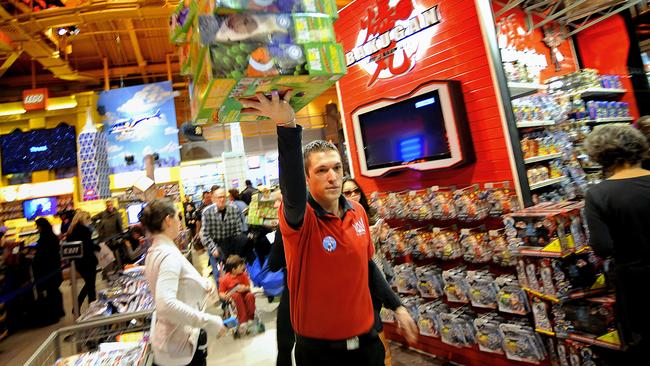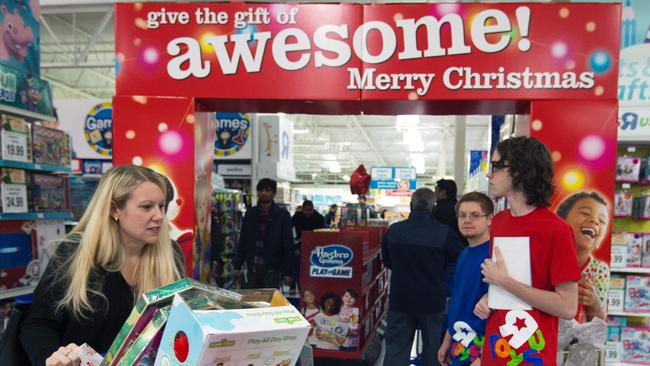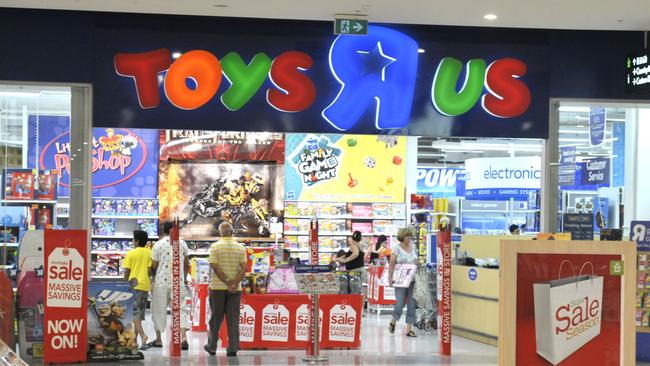Toys ‘R’ Us forced into bankruptcy
Toys ‘R’ Us, for decades the go-to spot for kids’ gifts, has fallen victim to debt and the rapid shift to online shopping.

Toys ‘R’ Us, the rainbow-coloured toy emporium that for decades was the go-to spot for birthday and holiday gifts, has filed for bankruptcy protection in the US, undone by a hefty debt load and the rapid shift to online shopping.
As part of the restructuring process, Toys ‘R’ Us plans to close some underperforming stores, according to people familiar with the matter.
Its remaining locations would be reconfigured to be more experienced-based, incorporating amenities such as in-store play areas, they added.
The company expects most of its stores will be open for the holidays and it will use a large bankruptcy loan to continue buying merchandise and funding its operations, the people said.
The company, which operates about 1700 stores around the world, was a classic example of a “category killer,” a huge specialty store with low prices that squeezed independent shops.
It swallowed up several rivals that have themselves filed for bankruptcy protection, including FAO Schwarz and Kay Bee Toys, a mall-based chain that liquidated hundreds of stores before it was sold.
“They are the last major freestanding toy retailer in the US,” said Jim Silver, the chief executive of TTPM, a website that reviews thousands of toys each year for consumers.
As the testing ground for new products, Toys ‘R’ Us often identifies hits before rivals, as it did with Zhu Zhu pets in 2009, Mr Silver said.
But like many other big-box chains, including Borders, Circuit City and Sports Authority, Toys ‘R’ Us struggled with the rise of discounters like Wal-Mart Stores and Target Corp, and more recently, Amazon.com.
It was late to develop and expand its e-commerce business and placed big bets on licensed toys for Star Wars and Lego movies that missed expectations.
The filing was triggered by vendors and suppliers tightening terms with the company ahead of the key US holiday selling season, which accounted for 40 per cent of its $US11.5 billion in revenue last year. For the past several years, the company has lost money in each quarter except its holiday quarter.
“None of the suppliers want this company to disappear, but they have a fiduciary responsibility to their own shareholders,” said a person familiar with the situation.

The toy industry is in tumult.
Lego earlier this month reported its first quarterly-sales decline in 13 years and announced plans to cut 8 per cent of staff.
Mattel, the maker of Barbie and Hot Wheels, replaced its CEO earlier this year after weak holiday sales. Shares of Mattel and Hasbro fell after The Wall Street Journal and others reported last week that Toys ‘R’ Us was preparing to seek bankruptcy protection before the holidays.
It is “probably a little bit of a perfect storm,” said Mark Carson, president of Fat Brain Toys, which began selling its educational and learning toys to Toys ‘R’ Us a little over a year ago. “There is a lot of general pressure on brick and mortar retail.”
In addition, he said, “they are obviously having to account for some of the sins of the past in their structure and their financing.”
The internet has also reshaped the marketing of new toys. Companies once relied on TV commercials to generate excitement for that season’s must-have items. But ratings for networks such as Nickelodeon and Cartoon Network have suffered as young viewers have turned to commercial-free streaming services such as Netflix. Children don’t have Facebook accounts, making it difficult for digital marketers to find ways to pick up the slack.
The Wayne, New Jersey, company had hired restructuring advisers at law firm Kirkland & Ellis and was working with Lazard to try to refinance its debt, which stood at about $US5 billion as of the end of April. The company had planned to update investors on its restructuring efforts next week when it was scheduled to report quarterly results.
Vanessa Mota, a lawyer from Forest Hills, New York, visited the combination Toys ‘R’ Us/Babies ‘R’ Us store in the Rego Center shopping mall to buy a doll for her 7-year-old daughter. While she occasionally buys online, where she says prices are better, she likes to visit stores “to touch it, to look at it, to walk around.”
The only thing she doesn’t like about shopping in the store? “The noise,” she said.
A Toys ‘R’ Us restructuring would add to a list of more than 20 retailers, including RadioShack and Payless Shoe Source Inc., that have filed for bankruptcy since the beginning of 2017. Another big-box chain, Staples Inc., recently agreed to be taken private in a leveraged buyout.
Toys ‘R’ Us was purchased for $US6.6 billion in 2005 by Vornado Realty Trust and private-equity firms Bain Capital and KKR & Co. The company remains heavily indebted from the buyout. That has limited its ability to invest in growth initiatives such as e-commerce.
The company was founded in 1948 by Charles Lazarus, a World War II veteran who started a baby furniture store in Washington, DC, to cater to the post-war baby-boom era. In 1957 he opened the first Toys “R” Us store. It was a novel concept: a toy supermarket with a broad assortment of products that customers picked off shelves to fill shopping carts. A cartoon giraffe named Geoffrey became the official company mascot appearing in TV and print ads.

The business was sold to a retail conglomerate that later filed for bankruptcy in 1974. Mr Lazarus took over the restructuring and divested all the non-toy businesses. He took the company public in 1978 and it opened hundreds of stores in the 1980s. The founder stepped aside as CEO in 1994. Two years later, the company opened its first Babies ‘R’ Us store, which now account for about 650 of the company’s locations.
During the 1990s, Toys ‘R’ Us was on a collision course with Wal-Mart, which, like rival Target, had made a play for toy sales by offering cut-rate prices during the holiday season. To differentiate itself, Toys ‘R’ Us focused on the depth and selection of merchandise. The strategy bred some success, with Toys ‘R’ Us often being one of the last destinations for people to buy a hot toy before Christmas, long after its competitors had sold out.
After going private in 2005, Toys ‘R’ Us experienced several years of sales growth and the company filed for an IPO in 2010. But those plans were withdrawn as its financial performance weakened. Sales have fallen each year since fiscal 2012 and profits have been uneven. In the year ended January 2017, the company lost $US36 million on sales of $US11.5 billion.
Dow Jones Newswires



To join the conversation, please log in. Don't have an account? Register
Join the conversation, you are commenting as Logout